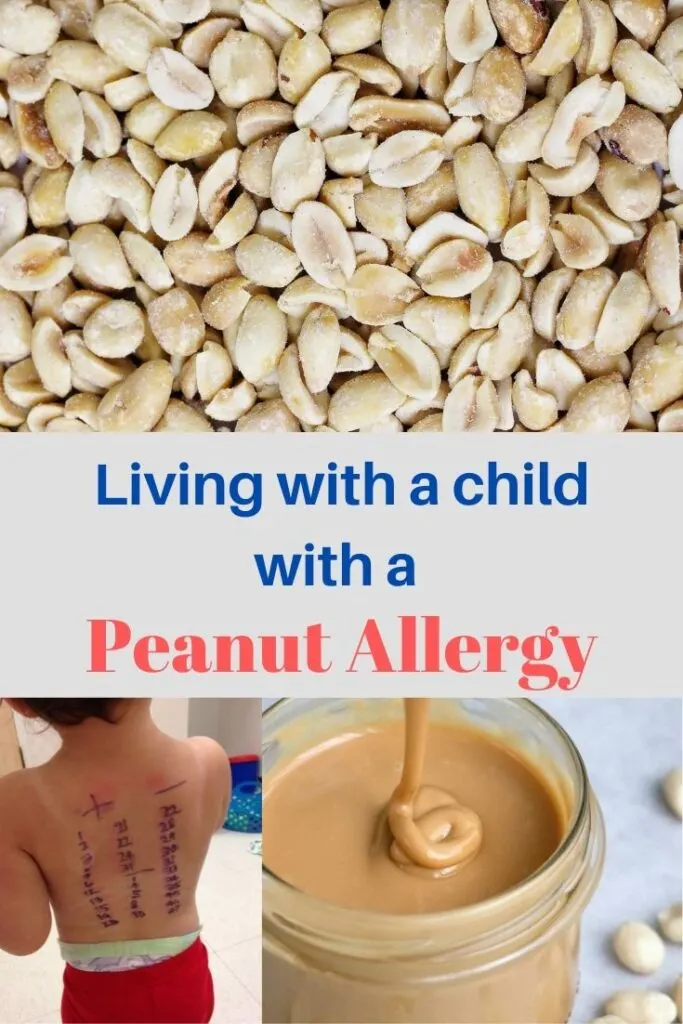To my fellow caregivers who are caring for a child with a peanut allergy. I’ve shared my experience with allergy testing as well as helpful things to know living with a kid with a peanut allergy.
When you hear the word peanut allergy what is your initial response? I used to think (before I had kids) that only immunocompromised children or children with underlying conditions have food allergies. There are a lot of things I “used to think” before I had kids. Of course after you have kids everything changes…including your mindset. I know you can probably relate.
We first noticed that my daughter might have a nut allergy when she licked an empty spoon of what used to have peanut butter on it and ended up with a rash around her mouth. I didn’t think anything about it at first but after five minutes, the rash was still there. At this point I realized this might be a reaction to the peanut butter so I gave her a little Benadryl.
After thirty minutes the rash wasn’t any worse, but it wasn’t a whole lot better either. I knew then that we were in for a trip to the allergist.
My daughter was about 18 months when this happened. This was in 2016 when the peanut introduction guidelines stated not to give a child any nut products until after 2 (these guidelines have since changed…more about this later in the article).

Nut allergy test and our experience
Most doctors will do a skin prick test to check for allergies. There are two ways to do this; the arm and the back. Since my daughter was young, they chose to use her back (adults are normally tested in the forearm).
Before the appointment, they asked us not to give her any antihistamines for at least two weeks. The antihistamines can potentially give a false negative reading.
After seeing the doctor and discussing the issue, he ordered the skin prick test to test for an array of food allergies (not just peanuts).
The nurse came in shortly after and prepared her back by cleaning the skin with an alcohol solution. She then made a series of marks on her back to keep track of the different allergens they would be testing for.
She placed a small drop of each allergen on the marked area and then lightly pricked it to allow the allergen to seep into her skin.
Now we played the waiting game. I can’t exactly remember how long we waited but it felt like a lifetime.
My daughter tolerated it ok. She cried a little while the test was being administered but overall once the prick was done, she was back to her normal self.
They rated the reaction by measuring how big each prick blisters (or how big the red mark is). They also tested for tree nuts, eggs and a handful of other common food allergies.
You can see on the picture below they use the + sign to measure a positive reaction and the – sign to measure a negative reaction.

The peanut allergy prick test results
As far as her test goes, the peanut and egg was positive. I can’t remember what the exact numbers were, but it was fairly reactive (meaning she had a significant allergy to both peanuts and eggs). She did not, however, test positive to tree nuts. You would think if you are allergic to one nut, you would be allergic to them all. Interesting right?
I have an older son that has a sensitivity to milk protein so we’ve always given him Almond milk instead of cow’s milk. Because of this, at a year old when we introduced regular milk to my daughter, we gave her almond milk too. Did introducing her to almond milk early on help erase a possible allergy to tree nuts?
Peanut introduction guidelines and how they’ve changed
Apparently the American Academy of Pediatrics thought there might be some legitimacy to this because only a short time after she was tested, they changed their peanut introduction guidelines. Instead of introducing peanut products after 2 (which is what we were instructed to do), they published new guidelines for introducing peanut foods to infants. WHAT THE HECK!
As a mom who trusts the Pediatricians instructions, it’s hard to understand how such an important (and potentially deadly) guideline can suddenly change.
For years (since 2012 when my son was born), all I heard was make sure not to introduce peanut butter before 2 because it could create an allergy with a deadly reaction. Hmmmmm.
Honestly, my first thought when my daughter reacted to that empty spoon with traces of peanut butter was that the allergy must have been caused by accidentally introducing the product before she was 2. Nope, couldn’t be that because the AAP changed their mind, LOL.
If you are wondering why peanut allergies are so common and why they are on the rise, check this post out.
Living with a peanut allergy for 5 years
Since that initial prick test five years ago, we’ve seen the allergist at least once a year since. They order a blood test a few weeks before the appointment and we go in to get the results. At that appointment is when they renew the epipen prescription and fill out paperwork for her school (for the epipen).
You know the most interesting part? Her blood test is always negative. Does this mean she doesn’t have an allergy anymore? No. Apparently they combine the bloodwork test results with the skin prick test and give you a number (how reactive you probably are to the allergen). They said since she was VERY reactive to the prick test, it doesn’t necessarily mean that negative blood test result is accurate.
So basically the negative blood work doesn’t mean anything. Talk about being confused…
Very soon we will be going in to the office to do a peanut allergy evaluation where they will give her a small amount of peanut butter and see how she reacts. I’ll update this post when we do.
What to know about foods cooked in peanut oil and a peanut allergy
There are two types of peanut oil: 1) unrefined peanut oil 2) refined peanut oil. The unrefined peanut oil is typically what causes the allergic reaction.
Unrefined peanut oil AKA Crude peanut oil, extruded, cold-pressed, gourmet, aromatic, expeller pressed oil
Unrefined peanut oil is oil that has NOT gone through the refining process and still contains the peanut protein. The peanut protein is what causes the allergic reaction. Steer clear of any product cooked with crude peanut oil.
Refined peanut oil
Refined peanut oil has been separated from the peanut proteins using chemical and mechanical processes. Because the peanut proteins are generally what causes the reactions, this type of peanut oil is mostly considered safe.
Foods made with crude peanut oil or unrefined peanut oil
Crude oil or unrefined peanut oil is used to enhance the flavor of food with a nutty, bold taste. You will find this type of oil in a lot of stir fry’s, sauces and marinades. Be careful of Asian food if you have a peanut allergy.
Chick-Fil-A peanut allergy?
Chick-Fil-A uses refined peanut oil which is generally considered safe for people to eat who have a peanut allergy. My daughter has never had any sort of reaction from eating Chick-Fil-A food.
Things to think about as a mom with a child who has a peanut allergy
- Get used to reading labels. If the food product has an association with nuts, it will be highlighted below the ingredient list in bold.
- Always keep multiple epipens. You will need to give them to grandparents, schools, friends or who ever your child visits. Make sure you, and anyone else knows HOW to use the epipen.
- Teach your child as early as you can to be mindful of his/her nut allergy. Teach them to always ask if there are nuts in the food product.
- Be mindful of holidays; especially Halloween. My daughter understood early on that she was not allowed to touch any Halloween candy until I looked through it. Be careful letting your child trick or treat with anyone who doesn’t understand the importance of their allergy. Also, nuts tend to be plentiful in holiday baking! Steer clear of casseroles baked breads and deserts unless you are 100% sure they are nut free.
- Even though a child’s school might have a nut free policy doesn’t mean that another child won’t bring a nut products to school. Most parents who don’t have a child with a nut allergy don’t think twice about sending a peanut butter sandwich or a packet of nuts for snack.
- Always carry extra nut free snacks and treats to birthday parties and celebrations so your child doesn’t feel left out if they can’t eat the food or desert provided. I learned this the hard way.
- Most of all, knowledge about the child’s allergy is key to preventing a reaction. Make it a known fact that he/she is allergic to peanuts.

My take away
The bottom line? We know she reacted to peanuts at one point in time, so there is always a chance she can react to it in the future (even if she doesn’t react in the office). I think we will always carry an epipen with us just in case. Peanut allergies are so unpredictable it’s not worth the risk.
Since she was initially tested five years ago, not much has changed. Luckily she hasn’t had a peanut product since that empty spoonful and if she does, I’m always prepared with an epipen.
I hope you’ve found this article helpful, insightful and comforting. It’s not the end of the world to get a peanut allergy diagnosis. Knowledge is key.
Take care and let us know if you have any questions.

Leave a comment